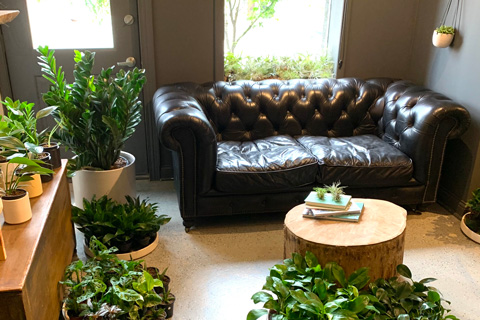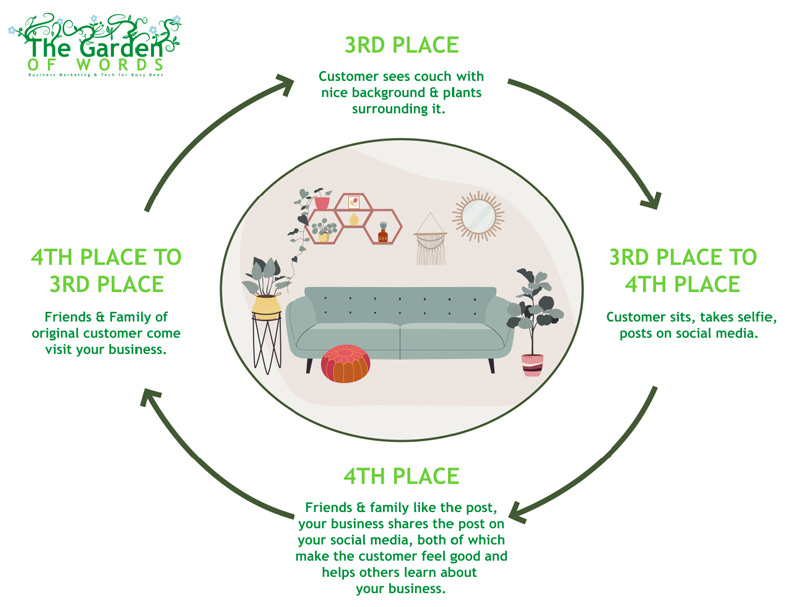11/1/2021
Couch to 5K: Marketing in ¾ Time
Katie Elzer-Peters

There’s a reason the Couch to 5K running program is successful. It helps people take small steps to achieve substantial results. What if you could grow your business with “couch marketing?” I think you can. Let’s substantiate that claim.
The Third Place
If you don’t want to be at home and you’re not at work, where do you go? Starbucks or its equivalent. Somewhere in between work and home where you can meet up with friends, relax, chat and have an experience.
Sociologist Ray Oldenburg coined the phrase, “The Third Place” to describe that type of space, while writing his 1989 book, “The Great Good Place.” In 2002 he published “Celebrating the Third Place: Inspiring Stories About the ‘Great Good Places’ at the Heart of Our Communities,” mentioning Starbucks as an example of a Third Place. And, like any brand good at marketing, they ran with it, becoming The Place of Record that people go outside home and work. Third Places are physical locations rooted in their communities. Sound familiar? Could a garden center be a Third Place?
The Fourth Place
In 2002, when “Celebrating the Third Place” was published, the Internet was a primordial soup compared to what it is now and social media didn’t exist. Almost 20 years later, we’ve added another plane of existence: the Fourth Place, or the digital realm. Gamers are the native species in this new frontier, but almost all of us visit constantly, pulling out our phones to snap pictures for Instagram, entertain ourselves with TikTok or start an argument with relatives on Facebook. We Zoom with work colleagues and family, and share Google docs with staff and with our book club members.
We feel massive amounts of anxiety about where to put our energy in the Fourth Place, as it relates to our Second Place, work. Should our business be on TikTok? Should we do Google advertising? Should we blog? If we don’t do any of that are we going to fail? If we try to do all of that at one time are we going to fail?
If you search for “Fourth Place” online, you’ll see that naming this 4th place we all occupy is a new-ish phenomenon and the handful of people talking about it in print tend to consider it separate from the other three spaces. One of the earliest mentions of the Fourth Place I could find was in a July 2020 article for Urbanarium. Author Anthonia Ogundele, a trained city planner, wrote:
“I would offer that, as citizens in the 21st Century, we need to acknowledge that we are often straddling between our digital and physical realties. These relationships are not mutually exclusive and impact how we interact and use the public realm. We need only look as far as Generation Z, who are defining what it means to occupy the 4th place.”
I think her take on the Fourth Place is the truest. The digital space really is inextricably linked with the other spaces of our lives. We live at work and online, at home and online, at the kids’ soccer games and online at the same time. Because of that straddling, business tactics, including marketing, will be most successful when they link the four the spaces we inhabit. It’s easier to do that if we think of all of the spaces we inhabit as physical spaces with boundaries and edges because then the spaces all seem real rather than conceptual. Often, that’s how the Fourth Place seems to me, leading to feelings of “I have to be everywhere at once.” You don’t and you can’t.
Marketing across places or spaces is usually described as “omnichannel marketing,” a nebulous term hard to grasp if you don’t live inside a consulting firm. It also perpetuates the “everywhere at once” feeling, so let’s rebrand. From now on, it’s “couch marketing.”
Place 3.5: The Couch
Do you have a couch at your garden center? If not, get one.
All of your competitors have couches. No, not the big box stores (although during the summer they do have patio furniture); they aren’t your main competition anymore. U.S. Census Bureau data indicates that 4.3 million new businesses were started in 2020, a 24% increase over 2019 and a 51% increase over the average from 2010-2019. If you look around, you can tell. Your competition is now in your own backyard, in the form of houseplant stores, makers’ markets and pop-up businesses. There’s also more competition from online retailers. Their “couches” are their social media platforms where they can re-share Instagram stories or customer pictures.
Brick-and-mortar garden centers have an advantage over online retailers because you can have actual couches in your stores. “But the humidity!” you might say. (A shameless “Friends” reference, and the cast on that show, you know, were the OG couch sitters.) Outdoor furniture exists. Get some! Put some plants around it and make it pretty. Turn it into a place where customers can have a fun experience.
A physical couch holds space, or really, opens up space for the feelings a couch invokes:
• Welcoming
• Belonging
• Familiarity
• Comfort
In a September article for Forbes online, Brad Birnbaum, owner of Kustomer, a CRM platform, wrote, “Our research shows that 67% of customers expect retailers to know them and personalize how they interact.” Whether you know your customers’ names or not, you can make them feel like you do by providing a warm, comforting, welcoming in-store experience.
If you offer customers a way to have a warm, welcoming experience and to feel positive feelings, you can be certain that they’ll do your marketing for you. They’ll share their experience in the Third Place (a fun selfie in your store) in the Fourth Place (online). That feedback loop is your “Couch to 5k new customers” path.

The Experience IS the Marketing
The other thing your competitors do is invite people to “come hang,” using those exact words on social media posts. “Come share our space”—the “and shop while you’re at it,” remains unspoken. Businesses that invite customers to “come hang” have followings. They can sell merch.
While writing this, I received a regular marketing email from Tonkadale Greenhouse with the subject line “Fall Gear is Here!”—meaning their Tonkadale fall sweatshirts and knit caps. While visiting The Mustard Seed Market, a garden center in Blowing Rock, North Carolina, I picked up my own Mustard Seed sweatshirt because I’d had such a great experience there (in part, because I was welcomed to sit in a chair and draw and paint their beautiful displays) and I wanted to remember it.
In marketing, it’s easy to be fixated on numbers. How many clicks? What was the ROI? We want numbers that justify our decisions. The problem is that our customers don’t use numbers to make their decisions. If they did, they’d buy all of their plants from big box stores all the time, but they don’t. They buy from your competitors, the houseplant shops with the selfie walls and the couches or the online retailers that re-shared their Instagram stories, making them feel seen.
Maya Angelou said, “I've learned that people will forget what you said, people will forget what you did, but people will never forget how you made them feel.” Hit your customers in the feels. The numbers will follow. GP
Katie Elzer-Peters is the owner of The Garden of Words, LLC, a green-industry digital marketing agency. Contact her at Katie@thegardenofwords.com.